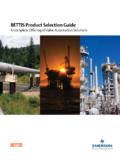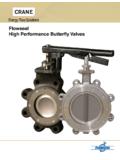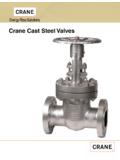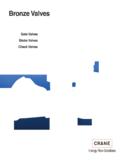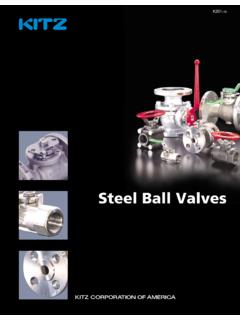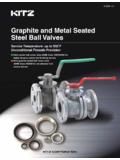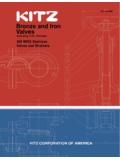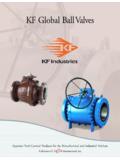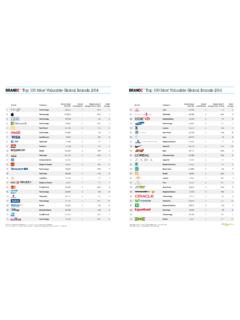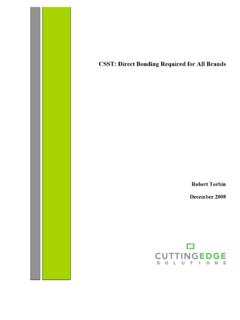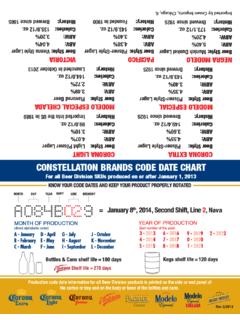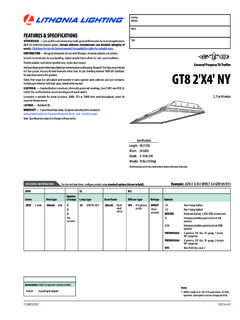Transcription of brands you trust. - AIV, Inc.
1 brands you Lined Plug ValvesContents Page Design features ..2 Lining materials ..4 Dimensions ..6 2-way operating torques ..8 2-way Cv Pressure-temperature ratings ..8 Methods of Actuator mounting dimensions ..9 3-way operating torques, Cv factors, and port arrangements ..10 Quality assurance, vacuum, oxygen, chlorine services, custom valves, actuators, locking devices ..10 Selection guide, how to Worldwide locations ..12 Tufline 2-way and 3-way fully lined plug valves feature an encapsulated plug rotating in a fully lined body.
2 Superior PFA linings economically handle the most corrosive in lined valve bodies and plugs incorporate dovetail recesses. With these recesses and machined grooves, linings are locked to the body and plug. The locked in lining resists shrink-age, collapse, and blow-out. Higher pressures and vacuums are easily handled. (See page 4 for comparisons of various lining methods.) Copyright Xomox Corporation 1998, 2009. All rights reserved. Tufline , Xomox and Matryx are registered trademarks of Xomox Corporation. Teflon is a registered trademark of DuPontTM used under license.
3 Xomox XRPTM is a trademark of Xomox continuous primary seal results from the interaction of the tapered plug and the tapered body bore. Cast-in ribs behind the body lining concentrate compression of the lining between the ribs and the plug. This assures a full circumfer-ential in-line seal. There is also a full circumferential seal around the plug, both above and below the flow passage. There are no cavities where flow media can accumulate or adjusted three adjusting bolts in the cover and the bottom adjustment bolt work together to assure a maximum sealing capability and an extended service & Corrosion Data.
4 Xomox publishes a comprehensive, 12-page brochure which lists nearly 500 chemicals and the relative appropriateness of various valve materials. This and much more in-depth information about the full line of Xomox valves and accessories is available on-line at Regional Offices, and Authorized Distributors are also listed on the web site. Secondary addition to the primary seals, there is a secondary seal system consisting of interacting components. The secondary stem seals, located above the plug, protect against external leakage up to 400 F. 1. The PTFE diaphragm is shaped into an inverted V at its inner circumference.
5 It seals at the cover joint and against the plug To help assure positive sealing and easy adjustment, the PTFE wedge ring fits into the V-formed inner circumference of the PTFE diaphragm. Sealing force is trans-mitted from the thrust collar (4) through the wedge ring. 3. A metal diaphragm is above the PTFE diaphragm and wedge ring. This metal diaphragm provides metal-to-metal contact at the cover joint. This prevents cold-flow of the PTFE configuration provides two independent compression seals between the body and the cover. One seal is plastic; the second is On top of the metal diaphragm is a floating thrust collar which acts to assure uniform pressure on all sealing Above the cover, on the plug shank of wrench operated valves, is a static eliminator which provides a positive electrical ground between the body and the plug.
6 6. Three adjusting bolts in the cover impart downward force through the thrust collar (4), to the wedge ring (2), then to the inner leg of the inverted V of the PTFE diaphragm (1). This, together with the opposing force of the plug, provides a pressure assisted seal which is not adversely affected by plug movement. The adjusting bolts also facilitate quick and easy adjustment of in-line , ANSI Class 150, fully lined plug valve. Figure No. 0611/2 - 12 inch .. PFA lined. 2-way, ANSI Class 300, fully lined plug valve. Figure No. 03611 - 6 inch .. PFA , ANSI Class 150, fully lined plug valve.
7 Figure No. 0311 - 4 inch .. PFA international flange ratings and drilling are available. Contact factory for more materials and corrosive applications, both the choice of lining materials and the method of lining are critical considerations. PFA lining material is melt-proces-sible. Melt-processibility means that this lining material can be locked to the valve body and plug using cast-in dovetail recesses and machined grooves. (PTFE cannot be locked in.)PFA s temperature ranges is: PFA is rated to 400 properties include: Chemical inertness Excellent permeation resistance Negligible moisture absorption Stress-cracking resistance Low coefficient of friction Insolubility in solvents Low adhesion properties Wide service temperature range Toughness is a class of perfluoropolymers that offers the processing ease of conventional thermoplastics but substantially extends its tempera-ture limits.
8 It is a copolymer that combines the carbon-fluorine backbone of fluorocarbons with a perfluoroalkoxy side is a true thermoplastic and is melt processible, allowing it to be molded to complex shapes. PFA resin has a branched polymer chain that provides good mechan-ical properties at melt viscosities much lower than those of PTFE. However, the unique branch in PFA is longer and more flexible, leading to improvements in high tempera-ture properties, higher melting point, and greater thermal stability. The strength and stiffness of PFA at high operating temperatures are equivalent to or better than those of PTFE, and creep resistance is better than PTFE over a wide temperature addition to properties in common with PFA has been found to be better in handling some monomers, such as butadiene.
9 It can be molded and machined to close tolerances for excellent seal and wear resistance between parts. 4 Compare lining are two ways to line valves, molding and forming. The lining method depends upon the lining material is melt processible. This means that it can be precisely molded to the valve body and locked into place. Locking is accomplished by molding the lining into dovetail recesses or grooves in the valve body. The locking resists liner of the limitations involved in conforming PTFE to the shape of the valve passage way, it is more vulnerable to is not melt processible.
10 It does not become molten at elevated temperatures. Consequently, it cannot be molded in the same way as PFA. As a valve liner, PTFE is limited to the blow-molding blow-molding, PTFE cannot be locked into the valve body. PTFE is susceptible to separation from the valve body in several ways including blow-out, collapse, and creep. PTFE at 2,000 XCompare PTFE, microscopic pores are present due to imperfect particle fusion during compensate for PTFE s greater porosity, thicker linings must be applied. Because of PTFE s greater lining thickness, the lining is less flexible and sealing is less flexible, less porous PFA linings assure better scanning electron microscope fractographs above illustrate the difference in valve lining materials.

